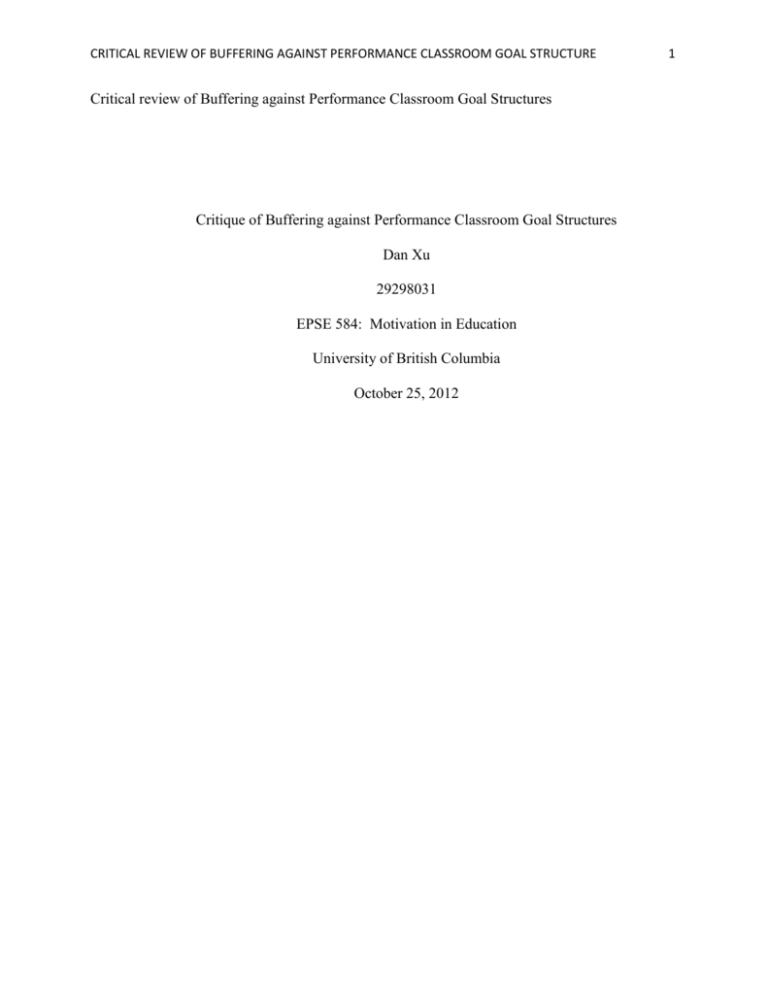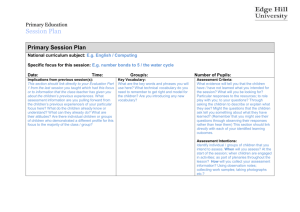Goal theory - Dan Xu e
advertisement

CRITICAL REVIEW OF BUFFERING AGAINST PERFORMANCE CLASSROOM GOAL STRUCTURE Critical review of Buffering against Performance Classroom Goal Structures Critique of Buffering against Performance Classroom Goal Structures Dan Xu 29298031 EPSE 584: Motivation in Education University of British Columbia October 25, 2012 1 CRITICAL REVIEW OF BUFFERING AGAINST PERFORMANCE CLASSROOM GOAL STRUCTURE 2 Nature of Study: One of the major concerns for high school students is the perceived competition between one another in achievement from one class to another. Cianni, Middleton, Summers, and Sheldon (2010) wanted to explore how a strong classroom community and an autonomy supportive teacher can mitigate the negative effects of a performance oriented classroom environment and students’ mastery goals. Ciani et al., (2010) hypothesized that if classroom community, teacher autonomy support, or a mastery classroom goal structure was made salient then an emphasis on performance goals in the classroom would not affect the students’ motivation to learn. Participants: Student participants were recruited from 15 high school mathematics classroom in a large Midwestern high school. Math represents a content area that is highly scrutinized by No Child Left Behind legislation, and thus represents a good content for exhibiting performance oriented contexts. In total over 178 students were used for the case study. Fifty-two percent of participating students were female. Age of participants ranged from 14-18 (Ciani et al. 2010). Research Design: The research was short term measuring only classroom goals structure, contextual buffers, and mastery goals at a single time point. The research took place over five different classrooms utilizing surveys as a way to gauge students’ motivational level. The survey was conducted in late October which allowed students adequate time to have developed perceptions of their goals and perceptions of the classroom environment. Each CRITICAL REVIEW OF BUFFERING AGAINST PERFORMANCE CLASSROOM GOAL STRUCTURE 3 student was given 10 minutes of class time to complete the survey. At no time was the survey taken by the same student in more than one class (Ciani et al. 2010). Surveys used by the researchers: 1. Three item scale from the Patterns of Adaptive Learning Scales 2. Mastery goal orientation scale from Patterns of Adaptive learning scales 3. Scale from the Group Work Attitudes Questionnaire 4. Autonomy Support Scale of the Learning Climate Questionnaire (Cianni et al. 2010) Results: Classroom Community and Autonomy: In the study Ciani et al. (2010) found that both classroom community and teacher autonomy support were able to significantly moderate, or buffer, the negative relationships between a performance classroom goal structure and students’ mastery goals. When either classroom community or teacher autonomy support was high, students reported high mastery goals regardless of the teacher’s emphasis on performance. Regarding the second buffer, autonomy support, Ciani et al. (2010) demonstrated that if students feel respected by the teacher, such that their preferences and ways of doing things are acknowledged and accommodated as much as possible, then a strong performance orientation on the part of the teacher is not harmful. Autonomy support enables students to internalize what they are doing so that they view their activity as important even if it is not enjoyable, or if it creates stress and pressure. CRITICAL REVIEW OF BUFFERING AGAINST PERFORMANCE CLASSROOM GOAL STRUCTURE 4 Main effects of performance and mastery goal structures: Findings suggest that a strong emphasis on both mastery and performance in the classroom may not be optimal for students’ mastery goals. Unlike teacher autonomy support and classroom community, a perceived emphasis on mastery goals by the teacher did not significantly moderate the relationship between a performance classroom goal structure and students’ mastery. It may be that a strong emphasis on mastery, amidst an equal emphasis on performance, is not sufficient to completely buffer the negative effects of a perceived performance oriented context on students’ motivation to learn (Ciani et al. 2010). Surprise/Contradictions to previous held beliefs: The purpose of the article was to highlight student perceptions within the classroom that might mitigate or buffer the relationship between performance oriented classrooms and a mastery goal approach to learning. The conclusion drawn from this study suggest that while the role of classroom environment is vital to the success of students mastery approach to learning, it ignores when and under what circumstances certain goal structures (performance/mastery) affect students motivation, or how certain aspects of the classroom environment (teacher support/community) can interact with a particular goal structure to alter its effects. Strength: The first strength of the article is the literature review conducted by Ciani et al. (2010) focuses on a wide range of theories that is interconnected with the theme of autonomy support and classroom community. The authors initially grounded their research in achievement goal theory as a way to target the reasons behind students’ CRITICAL REVIEW OF BUFFERING AGAINST PERFORMANCE CLASSROOM GOAL STRUCTURE 5 motivation to engage in class work (Ciani et al., 2010). This is important as it helps to narrow the focus of the study to elements within the theory that can help explain the various interactions within the setting. Through the introduction of goal achievement theory the authors delved deeper into student motivation by linking it with Deci and Ryan (1985) theory of self determination as a rationale in explaining how autonomy support is relevant in fostering mastery goals. Ciani et al. (2010) utilized a wide range of literature that spanned three decades from the 1980s in achievement goal theory and self determination theory to 2009 on work in relation to intrinsic motivation and teacher autonomy support. Overall, the authors presented a very detailed account of which theories of motivation the study was grounded in, how it connects to their hypothesis, and why it would matter to any teacher entering the field. The second strength offered by this article is the implications it has in regard to classroom practices. The authors came to two separate and interrelated conclusions; first classroom community and autonomy support are significant to buffer the negative relationship between a performance classroom goal structure and students’ mastery goals; second a strong emphasis on both mastery and performance in the classroom may not be optimal for students’ mastery goals. Limitations: First, data that are reported are correlational. The majority of measurements in relation to classroom goal structure, contextual buffers, and mastery goals were all done at a single time point by the same rater. This not only leads to method bias on the part of the researcher but also to the issue of follow up. How can anyone assess the perceptions of students’ motivation in regards to classroom goal structures in a 10 minute pullout CRITICAL REVIEW OF BUFFERING AGAINST PERFORMANCE CLASSROOM GOAL STRUCTURE 6 session? It is like striking up a conversation with a complete stranger on a bus and hoping that the information they provide are valid towards your end goal of publishing an academic paper. The problem with this approach is it does not allow the interviewer the opportunity to see whether or not the student’s perception of classroom goal structures has shifted. This is salient because late October is not the usual time when report cards are issued. If the interviewer had the opportunity to come back and reassess students’ perception of classroom goal structure after the first report would the results lean more in favor of performance orientation than mastery. Second, conclusions were unable to determine if the observed effects were a result of specific teachers, or more about the prevailing practices in the classroom. One of the prevailing problems with just eliciting feedback from students is that they do not know what areas of teaching practices (good/bad) to look for when assessing their teachers’ competencies in the classroom. As a result you receive a report that paints a rosy picture of how the student perceives they are doing academically. It may be that a teachers approach to classroom instruction e.g. choice, challenge, complexity, control, and care, can be viewed differently by students in other classes or by fellow teacher colleagues. A final point of concern from the current study is the small amount of between class variance in student perception of a performance classroom goal structure. This is due in part to the modest sample size and homogeneity of the classrooms (all mathematics). It is obvious that students’ perceptions would differ from subject to subject. It would be interesting to see how the same students would view performance CRITICAL REVIEW OF BUFFERING AGAINST PERFORMANCE CLASSROOM GOAL STRUCTURE 7 classroom goal structure in a Drama or English class where the grading might be more holistic. Implications for research /practice: The findings of this study can help teachers design classroom procedures that are more predictable to follow and offer choice in their teaching practices. Teachers can create routines and practice them daily with their students until they are comfortable with what are expected. Furthermore teachers can embed choices in their assignments and offer students the option of choosing their own topic in relation to the overarching theme of the unit. Teachers can teach students in accordance with their own beliefs and goal attainment e.g. some students may want to work on mastery thus we can provide a rubric that demonstrates their competencies in accordance with a set guideline; other students may want to outperform their peers which can be achieved based upon end of the unit examinations. Teachers can achieve both goals of mastery and high performance by setting high expectations in the classroom while maintaining autonomy support in relation to assignments. CRITICAL REVIEW OF BUFFERING AGAINST PERFORMANCE CLASSROOM GOAL STRUCTURE 8 Bibliography Ciani, K.D., Middleton, M.J., Summers, J.J., & Sheldon, K.M. (2010). Buffering against Performance Classroom Goal Structures: The importance of Autonomy Support and Classroom Community. Contemporary Educational Psychology, 35, 88-99.








